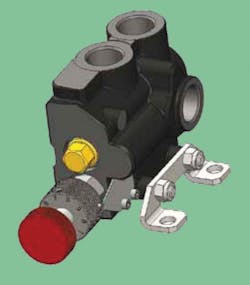Closed-loop electronic control systems exhibit the cutting edge of mobile electrohydraulics. But their price tag is prohibitively high for applications that don’t require such high precision and intelligent control. An example is the CV 2000 load-sensing, post-compensated sectional control valve from Nimco AB, Malmö, Sweden. The CV 2000 LS can be used in systems with both fixed and variable displacement pumps. The compensators in the sections allow all functions to work even when the pump is saturated. Together with Nimco’s variable-displacement pumps, the precise and efficient closed-loop system is controlled by Nimco’s EasyProg electronic control.
However, for many applications, such precise, closed loop control would be overkill. These situations call for a more cost-effective solution. For these cases, Nimco offers its PFCV series of pressure-compensated flow-control valves. Valves in the PFCV series can be used either as a single valve or in multiple units which are assembled together as one block for multiple function usage.
In its most basic version, the PFCV regulates pump flow to an actuator at a preset speed regardless of load pressure and diverts excess flow back to tank. If multiple valves are stacked together into one block or mounted in succession, they will divert both the regulated and by-passed flow to a second or third valve circuit to serve subsequent functions.
A check valve can be incorporated between the regulated priority flow line and the bypass line as a standard option. This check valve will prevent motor cavitation when the flow is suddenly reduced or cut off. A torque limiting option uses an integrated relief valve to set the maximum pressure available to one or more motors when the valve is connected in series. Another option integrates a pressure limiter valve in each section when PFCVs are connected in parallel. This allows each motor to operate at a preset pressure regardless of the pressure settings of other motors.
When regulated flow must be activated or deactivated, the PFCV series valves can be equipped with either a 12 or 24 Vdc solenoid valve that integrates into any electrical control system or used as a safety feature.
For more information, visit Nimco AB at www.nimco-controls.com. In the US and Canada, call Nimco Inc., Sturtevant, Wis., at (262) 884-0950 or email [email protected].


